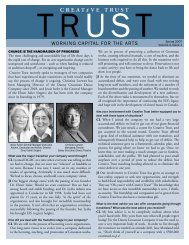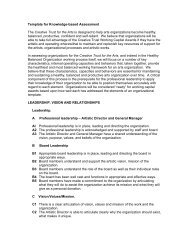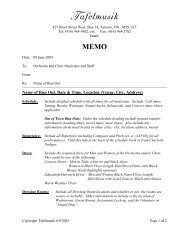20 Questions - Canadian Institute of Chartered Accountants
20 Questions - Canadian Institute of Chartered Accountants
20 Questions - Canadian Institute of Chartered Accountants
Create successful ePaper yourself
Turn your PDF publications into a flip-book with our unique Google optimized e-Paper software.
Strategic Planning<br />
Strategic planning can be described as determining where the organization is<br />
now, where it would like to be in the future, and how it intends to get there.<br />
Most not-for-pr<strong>of</strong>it organizations start <strong>of</strong>f with a fairly clear idea <strong>of</strong> what they<br />
want to accomplish and what they stand for. The founding members spend<br />
time talking about these things and, if they incorporate, they write them down<br />
as the purpose <strong>of</strong> the organization.<br />
Over time, the original passion and energy can get diluted by practicalities<br />
and problems, circumstances and needs may change and the organization risks<br />
losing its sense <strong>of</strong> purpose, relevance and commitment. Strategic planning is a<br />
way to invigorate and strengthen an organization by establishing longer range<br />
objectives and focusing on the important - not just the urgent. The results <strong>of</strong><br />
planning provide information for members and funding sources.<br />
Strategic planning also provides guidance to staff and volunteers for developing<br />
work plans, projects and budgets and for the effective management <strong>of</strong> resources.<br />
A strategic plan describes how an organization intends to move from where it is<br />
now towards its vision in accordance with its mission, values and tolerance for<br />
risk. In so doing it plans to use its strengths to take advantage <strong>of</strong> opportunities,<br />
remedy its weaknesses and to avoid or mitigate threats. The plan also<br />
establishes how the organization will measure progress in meeting its objectives.<br />
This section explores these concepts and concludes with discussions <strong>of</strong> the<br />
responsibilities for planning and <strong>of</strong> how the planning elements described above<br />
can fit into a planning process. (<strong>Questions</strong> 11 and 12)<br />
Appendix 2 is an example <strong>of</strong> how all the elements in the planning process can<br />
fit together.<br />
1. What is the organization’s vision?<br />
There are no formal rules for visions – what organizations want to accomplish.<br />
Organizations adopt visions that work for them and inspire their members, staff<br />
and supporters. For example: vision statements may describe:<br />
• how things would be different as a result <strong>of</strong> the organization’s activities<br />
• how the organization wants to be seen by others<br />
Good visions are aspirational. Some are hard-to-reach ideals as in Martin<br />
Luther King’s memorable words “I have a dream…”. Others are more modest<br />
or describe objectives that are achievable in the present or near future. In either<br />
case, the vision helps establish the unique contribution that the organization<br />
makes to society (the “value proposition” in business language) and provides<br />
justification for support from its community, members, donors, sponsors and<br />
government.<br />
From a practical perspective a vision can be a quick, memorable way to describe<br />
the organization’s reason for being. This can be valuable in times <strong>of</strong> difficulty<br />
or crisis when it helps to remember what is really important. For these and<br />
other reasons, the vision is <strong>of</strong>ten published in the organization’s annual reports,<br />
brochures and fund-raising materials.<br />
Recommended practices<br />
• The vision clearly explains what the organization aspires to accomplish<br />
• The board approves the vision<br />
• The vision is communicated to staff, volunteers, members and other<br />
stakeholders<br />
Visions<br />
“Creating a world where no <strong>Canadian</strong> fears cancer.”<br />
<strong>Canadian</strong> Cancer Society<br />
“Queen’s University will be recognized as an innovative, inclusive<br />
and rigorous community <strong>of</strong> learning and discovery that is committed<br />
to serving as a national resource for the betterment <strong>of</strong> our global<br />
society.”<br />
Queen’s University<br />
Vision and Mission<br />
Active Healthy Kids Canada<br />
Our Vision: A nation <strong>of</strong> active, healthy kids.<br />
Our Mission: Active Healthy Kids Canada is committed to inspiring<br />
the nation to engage all children and youth in physical activity.<br />
5












